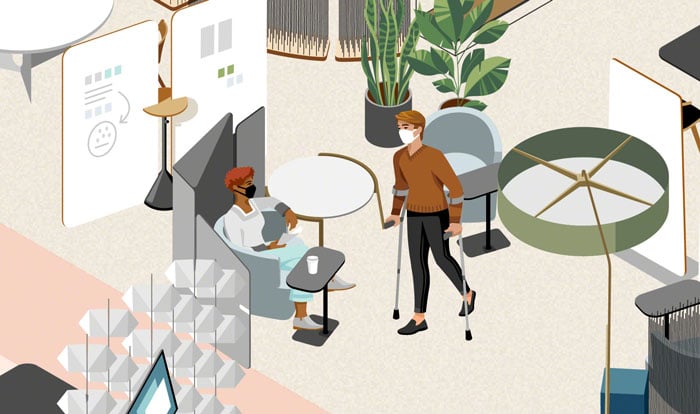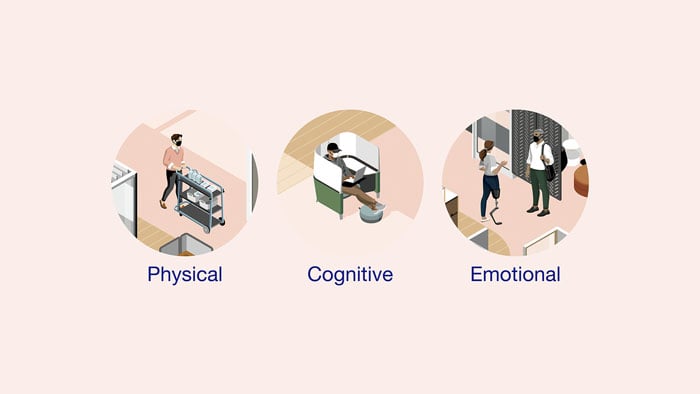It's time for an experience that's fundamentally better
The pandemic has reshaped many aspects of our lives, including where and how people want to work. Their experiences working from home, and what they face when they return to the office, have influenced what they want and expect to see in the workplace going forward. The things they liked about their office before the crisis have become even more important, while the things that frustrated them will become an even bigger barrier if not addressed.
People have had vastly different experiences while working from home and they've learned from what they’ve been through. Those experiences shape their expectations for what they want work to be like in the future.
What People Need and Expect
To understand the impact the pandemic has had on what people need and expect in the office, Steelcase conducted research in 10 countries and engaged over 32,000 people in multiple studies. Synthesissing these studies uncovered five overarching needs that will drive macro shifts in the overall work experience and lead to new ways of planning and designing offices.
To Be Safe and Feel Safe
Offices never had to help mitigate the spread of disease, but people are now pandemic-aware. They will make decisions about where to work based on a new set of safety standards to help prevent transmission in the office, just as they expect safety standards for things like fires or tripping hazards.
New Health + Safety Priorities
73% Air quality
73% Adherence to safety protocols
72% Facility cleanliness
71% Physical distancing + boundaries
69% Density
66% Visitor protocols
59% Food and beverage safety

A Deeper Sense of Belonging
Feeling isolated while working from home is the biggest concern people identified in every country and their top reason to return to the office is to connect with co-workers. People want to feel a sense of belonging at work, which is not only good for their wellbeing but it also helps business results — feeling a strong sense of community is the top indicator of people’s productivity, engagement, innovation and commitment to the organisation.
The top reasons people want to return to the office:
#1 Connect with colleagues
#2 Reconnect to the organisation and shared purpose

To Be Productive
People’s desire to accomplish something meaningful, has only heightened during the crisis. While some experienced “panic productivity” in the early pandemic days, most simply want to be of value and feel their work has purpose. The most important things people want their workplace to support are very pragmatic.
Holistic Comfort
Pre-pandemic, 40%* of people said they needed to change postures frequently because of physical discomfort. During stay-at-home orders many people had to improvise and work from sofas, kitchen tables and even beds. Pain, distractions and stress have caused people to yearn for a broad interpretation of comfort, especially after such a disruptive time. They need the ability to work in a range of postures, change settings and to move throughout their day. They need a quiet, distraction free environment when they need to focus and to feel connected to their coworkers and the organisation’s purpose.
Greater Control
People want options so they can choose where to work or to adapt spaces based on the task they’re doing or how they like to work personally. While some people feel working from home has allowed them to navigate their day and avoid distractions, nine of 10 countries rank a “quiet, professional environment” in their top five reasons for wanting to return to the workplace, suggesting that home is not always ideal for focus. Teams also need control over the level of privacy and the flexibility to move things around to best suit their work.
Macro Shifts In The Work Experience
People’s expectations about their work experience changed during the pandemic. Living through a life-altering experience has caused many to think about what’s most important to them and to question assumptions about how work should happen. And leading organisations are listening. They see this moment as an opportunity to reinvent their policies, offices and overall work experience. This will lead to macro level shifts in four key areas.
Design Safer Workplaces
Seventy-three percent of U.S. employees* said their top concerns are air quality and adherence to safety protocols which means behavioural strategies, such as mask wearing and distancing, need to be augmented with changes to the built environment.
Organisations can make the workplace even safer by intentionally designing the built environment to help mitigate disease transmission. Understanding how pathogens move through an environment will help companies develop new systemic strategies to help prevent infections at work.

Design for Productivity
People’s desire to accomplish something meaningful, has only heightened during the crisis. Before the pandemic people were frustrated with workplaces that didn’t give them ways to control their privacy and do focused work. During the pandemic, working from home didn’t make that any better for many people: engagement declined 14% and productivity dropped 12% among employees who were unsatisfied with their work-from-home situation, especially the longer they did it.
The top three things people say they want from their office are all about being more productive: to collaborate with others effectively, easier access to tools and resources and the ability to focus. People want a better experience in which they can easily shift between group and solo work in both physical and digital environments.
Design to Inspire
People who have lived through a crisis want inspiration — they want to feel a part of something meaningful. The top two reasons people say they want to be back in the office are to connect with colleagues and feel a sense of shared purpose with the organisation. These are both attributes of a strong community, along with trust, inclusivity and resilience. In turn, a strong community correlates with key business outcomes — engagement, productivity, innovation and retention. The workplace can intentionally foster meaningful interactions and signal that change and adaptation are part of the culture and something to be embraced.
Design for Flexibility
Historically designed for permanence, buildings and offices have been dominated by fixed architecture, power and furnishings. Going forward, organisations will offer more flexible work policies and they will need places that can adapt easily to the changes in where and how people work, and respond to changing business circumstances. Workplaces will need to embrace multi-use spaces that can support diverse types of activities. Furnishings will easily move to allow spaces to expand and contract as needed.
While living through a crisis has not been easy on anyone, it has caused people and organisations to think about our shared humanity and what we want to achieve together. We can use this moment as a catalyst for reinventing an office that is not just a container for work, but a place that creates a community where people can feel a renewed sense of belonging, resilience and purpose.
You can download the full Steelcase report here.
Source: Steelcase Work Experience Diagnostic Study conducted in September 2020 in 10 countries.




.jpg?width=700&name=20-0146627_Masks-(1).jpg)





.png)



